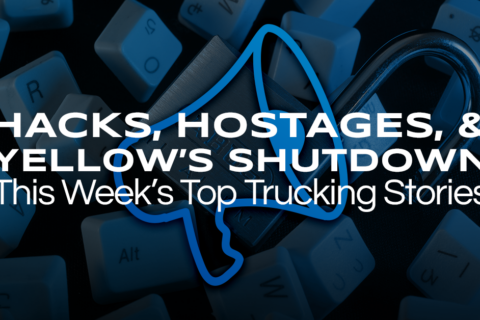Small Fleets Shine, FMCSA Focuses & Penalties Unveiled: Stories From The Trucking World
Ever thought about what drives the trucking and logistics industry forward? Dive into this week’s key moments and trends that are shaping tomorrow. This week brings fresh insights into the unexpected resilience of small and medium fleets during tumultuous times, the penalties faced by a trucking firm due to environmental negligence, and the keen eye the FMCSA has on the enduring issue of detention time. In an era where the journey of commercial drivers, logistics personnel, and industrial staff is paved with change, these summaries shed light on pivotal moments and trends that matter the most. The Rise of Small Fleets Amidst the challenges faced by the trucking industry in 2023, small and medium fleets have showcased resilience and strength. Large fleets reported dwindling revenues and profits in both Q1 and Q2, causing surprise amongst industry leaders like Werner’s CEO, Derek Leathers. He acknowledged underestimating the cash reserves these smaller carriers had built during the COVID-19 pandemic. This financial backbone has enabled them to endure longer than what industry experts had predicted. Industry Trends & Resilience Despite the sharp increase in fuel prices and a dip in rates, the trucking sector hasn’t witnessed a significant reduction in capacity. Contradicting the American Trucking Associations’ “driver shortage” claim, actions by large fleets, such as Knight-Swift closing many CDL school locations, suggest an oversupply of capacity. The number of active truckers remains high, with Leathers commending the resilience of small carriers, who have survived longer than anticipated under challenging conditions. He attributed this durability to factors like the 2022 freight market peak, federal stimulus, and decreased fuel costs. However, he also cautioned that as cash reserves deplete, the re-entry of these carriers into the market might become less probable. Changing Tides in Trucking The trucking industry, with its fluctuating rates and fuel costs, has forced businesses to adapt. A decline was noticed in the dry van spot rates, which now hover around $2/mile. Additionally, Leathers mentioned that many new trucking businesses have been deactivated, with the FMCSA reporting net truck deactivations for 44 consecutive weeks. While some of these might be single truck owner-operators who may have shifted gears, the overall number of active truckers still remains higher than demand. Big Fleets Aren’t Exempt It’s crucial to understand that large fleets like Werner aren’t shielded from industry pressures. As smaller fleets and owner-operators demonstrate their ability to navigate downturns and challenges, larger entities, including Werner, reported significant profitability drops, with the company experiencing a 37% decrease in the last quarter. This is a testament that even substantial players are not immune to the effects of a declining freight market. 🔗 Read the full article here Trucking Firm Faces Penalties In a recent decision by the Ontario provincial court, Jagger Canada Inc., a trucking company based in Etobicoke near Toronto, was fined for its negligence following a 2019 fuel spill incident. This over-the-road carrier faced three convictions under the Environmental Protection Act and was imposed a fine of $30,000, accompanied by a $7,500 victim fine surcharge. The company’s fleet consists of five drivers and four trucks, as per the Federal Motor Carrier Safety Administration. Overdue Cleanup Measures The fuel spill event transpired in November 2019 close to Neys Provincial Park, about 18 miles from Marathon, involving a commercial truck from Jagger Canada. Ontario provincial authorities, after visiting the accident scene, spotted a visible fuel sheen on the highway, with oil and fuel dispersed amongst rocks and snow nearby. Despite being informed by officials a month post-incident about its legal obligation for the spill cleanup, Jagger Canada did not meet the January 2020 deadline. However, by October 2020, the trucking firm’s insurance provider confirmed the completion of the cleanup, which was later verified and approved by provincial officials. 🔗 Read the full article here Detention Time Under Scrutiny The Federal Motor Carrier Safety Administration (FMCSA) has set its sights on examining the impacts of detention time within the trucking industry, particularly concerning its implications on safety. Slated for publication in the Federal Register on Aug. 24, FMCSA will be welcoming public insights on the proposed research named “Impact of Driver Detention Time on Safety and Operations.” Detention time, essentially the duration truck drivers spend waiting at shippers or receivers for loading or unloading, often goes uncompensated as most drivers earn by the mile. Aiming for a Comprehensive Analysis By pooling data from around 80 motor carriers and 2,500 commercial vehicle drivers, the FMCSA aspires to gain a comprehensive understanding of the repercussions of prolonged detention on driver safety and operational facets of the motor vehicle sector. This move traces back to the 2021 infrastructure law, which mandated a deep dive into the trucking industry’s detention time prevalence. Previous research by the DOT’s Office of Inspector General indicated a direct correlation between increased detention time and escalated crash risks, emphasizing that a mere 15-minute addition could spike crash rates by 6.2%. With estimated annual costs ranging from $1.1 to $1.3 billion due to detention time, the upcoming study will furnish updated cost evaluations, encompassing lost productivity, supply chain disruptions, and the repercussions on crashes, both fatal and non-fatal. 🔗 Read the full article here Before You Hit The Road… The stories curated in this collection are but a snapshot of the vast and multifaceted world of trucking and logistics. The adaptability of small fleets, the accountability that comes with environmental responsibility, and the persistent scrutiny on detention times all provide invaluable insights into the challenges and triumphs of the industry. We’d love to hear your thoughts on these articles in the comments below. Remember to stay updated and check back next week for another edition of Optimum Logistic’s weekly news recap. Safe travels and see you on the road! If you made it to this part of the article, we’d just like to take a moment to thank you for taking the time to read this weekly recap. Be safe out there and as always, If you’re in search of CDL A, B, or warehouse…











Recent Comments